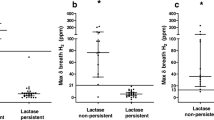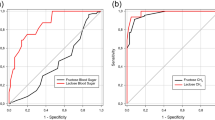Abstract
Introduction
Diagnosing lactose malabsorption is usually based on hydrogen excretion in breath after a lactose challenge. However, a proportion of subjects with lactose malabsorption will not present a rise in hydrogen. Measuring excretion of methane or stable isotope labeled 13CO2 after ingestion of 13C-lactose has been proposed to mitigate this problem.
Objective
The aim of the study was to assess the performance of measuring methane and 13CO2 in individuals with normal hydrogen excretion compared to a genetic lactase non-persistence test.
Methods
Individuals referred for lactose breath testing and healthy controls were included. Participants received 13C-enriched lactose, performed breath testing, and underwent genotyping for a marker of lactase non-persistence (13910C*T). Using genotype as gold standard, the performance of measuring methane and 13CO2 excretion was assessed.
Results
151 subjects participated in the study, 50 of which presented a lactase non-persistent genotype. Of these, 72% were correctly diagnosed through hydrogen excretion of ≥ 20 ppm above baseline. In subjects with normal hydrogen excretion, cumulative 13C excretion had an area under the curve (AUC) of the receiver operating characteristics (ROC) curve of 0.852. Sensitivity was 93% and specificity was 51% for the current cutoff of 14.5%. The optimal cutoff was 12.65% (sensitivity 93%, specificity 70%). The ROC curve of peak methane had an AUC of 0.542 (sensitivity of 14%, specificity of 91% for cutoff ≥ 10 ppm).
Conclusions
In individuals with genetically demonstrated lactase non-persistence and negative hydrogen breath test, the use of 13C-lactose with measurement of 13CO2 excretion and hydrogen is a well-performing test to detect the lactose malabsorption and performs better than methane in our cohort.

Similar content being viewed by others
References
Deng Y, Misselwitz B, Dai N, Fox M. Lactose Intolerance in Adults: Biological Mechanism and Dietary Management. Nutrients 2015;7(9):8020–8035.
Misselwitz B, Butter M, Verbeke K, Fox MR. Update on lactose malabsorption and intolerance: pathogenesis, diagnosis and clinical management. Gut 2019;68(11):2080–2091.
Enattah NS, Sahi T, Savilahti E, Terwilliger JD, Peltonen L, Järvelä I. Identification of a variant associated with adult-type hypolactasia. Nat Genet 2002;30(2):233–237.
NM_002299.2(LCT):c.-13907C>T AND Lactase persistence - ClinVar - NCBI [Internet]. (2022). https://www.ncbi.nlm.nih.gov/clinvar/RCV000008124.4/.
Hammer HF, Fox MR, Keller J et al. European guideline on indications, performance, and clinical impact of hydrogen and methane breath tests in adult and pediatric patients: European Association for Gastroenterology, Endoscopy and Nutrition, European Society of Neurogastroenterology and Motility, and European Society for Paediatric Gastroenterology Hepatology and Nutrition consensus. United European Gastroenterol J 26.
Rezaie A, Buresi M, Lembo A et al. Hydrogen and Methane-Based Breath Testing in Gastrointestinal Disorders: The North American Consensus. Am J Gastroenterol 2017;112(5):775–784.
Ianiro G, Pecere S, Giorgio V, Gasbarrini A, Cammarota G. Digestive Enzyme Supplementation in Gastrointestinal Diseases. Curr Drug Metab 2016;17(2):187–193.
Vernia P, Camillo MD, Marinaro V, Caprilli R. Effect of predominant methanogenic flora on the outcome of lactose breath test in irritable bowel syndrome patients. Eur J Clin Nutr 2003;57(9):1116–1119.
Hiele M, Ghoos Y, Rutgeerts P, Vantrappen G, Carchon H, Eggermont E. 13CO2 breath test using naturally 13C-enriched lactose for detection of lactase deficiency in patients with gastrointestinal symptoms. J Lab Clin Med 1988;112(2):193–200.
De Geyter C, Van de Maele K, Hauser B, Vandenplas Y. Hydrogen and Methane Breath Test in the Diagnosis of Lactose Intolerance. Nutrients 2021;13(9):3261.
Houben E, De Preter V, Billen J, Van Ranst M, Verbeke K. Additional Value of CH4 Measurement in a Combined (13)C/H2 Lactose Malabsorption Breath Test: A Retrospective Analysis. Nutrients 2015;7(9):7469–7485.
Youden WJ. Index for rating diagnostic tests. Cancer 1950;3(1):32–35.
Mandrekar JN. Receiver Operating Characteristic Curve in Diagnostic Test Assessment. Journal of Thoracic Oncology 2010;5(9):1315–1316.
Gasbarrini A, Corazza GR, Gasbarrini G et al. Methodology and indications of H2-breath testing in gastrointestinal diseases: the Rome Consensus Conference. Aliment Pharmacol Ther 2009;29(Suppl 1):1–49.
Hammer K, Hasanagic H, Memaran N, Huber W-D, Hammer J. Relevance of Methane and Carbon Dioxide Evaluation in Breath Tests for Carbohydrate Malabsorption in a Paediatric Cohort. Journal of Pediatric Gastroenterology and Nutrition 2021;72(3):e71.
Fritscher-Ravens A, Pflaum T, Mösinger M et al. Many Patients With Irritable Bowel Syndrome Have Atypical Food Allergies Not Associated With Immunoglobulin E. Gastroenterology 2019;157(1):109–118.e5.
Yang J, Deng Y, Chu H et al. Prevalence and Presentation of Lactose Intolerance and Effects on Dairy Product Intake in Healthy Subjects and Patients With Irritable Bowel Syndrome. Clinical Gastroenterology and Hepatology 2013;11:262–268.e1.
Acknowledgments
The authors wish to thank Geert Verbeke and Steffen Fieuws for statistical assistance and Anniek Corveleyn Bruno Vankeirsbilck, Nicole Gorris, Christine Dewit, and Helga Ceulemans en Nicole Pieters for technical assistance.
Funding
LMB received funding from a Postdoc.Mobility grant from the Swiss National Science foundation (P500PM_206612). TV is supported by a senior clinical research mandate of the Flanders Research Foundation (FWO Vlaanderen). JT received funding through a Methusalem grant from the KU Leuven.
Author information
Authors and Affiliations
Corresponding author
Ethics declarations
Conflict of interest
Authors declare that they have no competing interest.
Additional information
Publisher's Note
Springer Nature remains neutral with regard to jurisdictional claims in published maps and institutional affiliations.
Rights and permissions
Springer Nature or its licensor (e.g. a society or other partner) holds exclusive rights to this article under a publishing agreement with the author(s) or other rightsholder(s); author self-archiving of the accepted manuscript version of this article is solely governed by the terms of such publishing agreement and applicable law.
About this article
Cite this article
Balsiger, L.M., Houben, E., Vanuytsel, T. et al. Added Value of 13C Analysis in Breath Tests in H2-Negative Subjects to Diagnose Lactose Malabsorption: A Proof of Concept Study. Dig Dis Sci (2024). https://doi.org/10.1007/s10620-024-08304-0
Received:
Accepted:
Published:
DOI: https://doi.org/10.1007/s10620-024-08304-0




